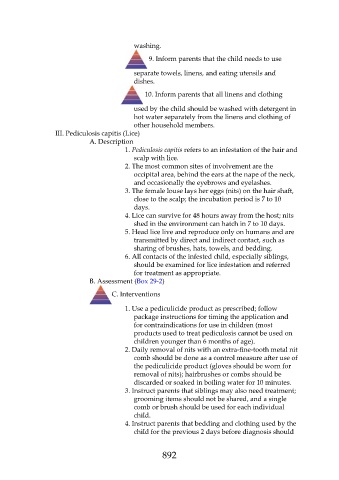Page 892 - Saunders Comprehensive Review For NCLEX-RN
P. 892
washing.
9. Inform parents that the child needs to use
separate towels, linens, and eating utensils and
dishes.
10. Inform parents that all linens and clothing
used by the child should be washed with detergent in
hot water separately from the linens and clothing of
other household members.
III. Pediculosis capitis (Lice)
A. Description
1. Pediculosis capitis refers to an infestation of the hair and
scalp with lice.
2. The most common sites of involvement are the
occipital area, behind the ears at the nape of the neck,
and occasionally the eyebrows and eyelashes.
3. The female louse lays her eggs (nits) on the hair shaft,
close to the scalp; the incubation period is 7 to 10
days.
4. Lice can survive for 48 hours away from the host; nits
shed in the environment can hatch in 7 to 10 days.
5. Head lice live and reproduce only on humans and are
transmitted by direct and indirect contact, such as
sharing of brushes, hats, towels, and bedding.
6. All contacts of the infested child, especially siblings,
should be examined for lice infestation and referred
for treatment as appropriate.
B. Assessment (Box 29-2)
C. Interventions
1. Use a pediculicide product as prescribed; follow
package instructions for timing the application and
for contraindications for use in children (most
products used to treat pediculosis cannot be used on
children younger than 6 months of age).
2. Daily removal of nits with an extra-fine-tooth metal nit
comb should be done as a control measure after use of
the pediculicide product (gloves should be worn for
removal of nits); hairbrushes or combs should be
discarded or soaked in boiling water for 10 minutes.
3. Instruct parents that siblings may also need treatment;
grooming items should not be shared, and a single
comb or brush should be used for each individual
child.
4. Instruct parents that bedding and clothing used by the
child for the previous 2 days before diagnosis should
892

